 |
|
 |
Increasingly, the Canadian public was calling for official adoption of a distinctive flag. The Manitoba Free Press suggested blue stars in the shape of the Big Dipper on a white background; a contest in La Presse in 1926 produced several hundred designs from three provinces. In 1928, under the heading "Time for Action," the Winnipeg Free Press was prompted to write: "Let Parliament authorize...a distinctive Canadian flag, showing the Union Jack, a maple leaf, the North Star, or some insignia that speaks for Canada, and it will be found that the Canadian people warmly approve. A people without enough gumption to provide a flag for themselves to speak to them of their own country and their faith in their country will never amount to much."
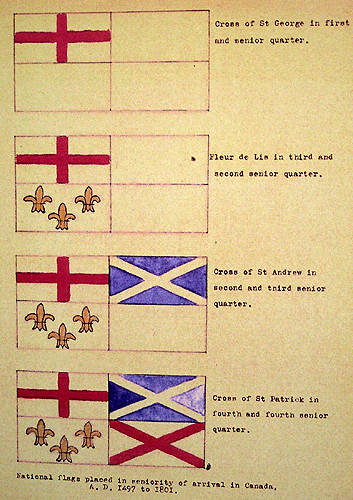 |
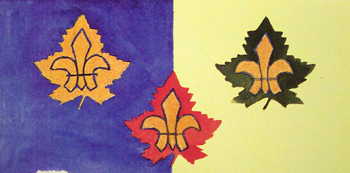 |
Illustrations and proposed flag designs from Lt.Col. T.B. Monk's A National Flag for Canada: Its Symbolism and Historical Growth, December 1936. Monk wrote, "I believe all true Canadians will agree that the necessity of a distinctive Canadian symbol that will create and intensify a deeper Canadian consciousness, and thereby develop a broader basis of union throughout Canada, becomes daily more apparent." (Saskatchewan Archives Board, C.R. McIntosh Papers) |
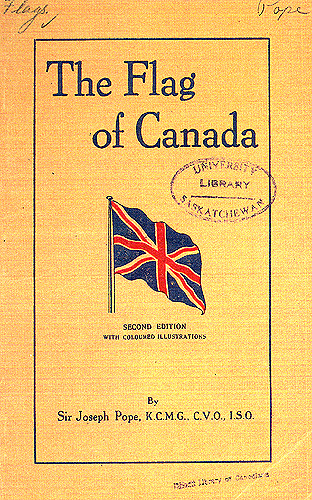 |
Pope was proud to write in defence of the Union Jack: "Canada forms a portion of the dominions of the King of England - as much so...as does Surrey of Kent." Quoting from an 1885 speech by Sir John A. Macdonald, he added: "I believe that if any party or person were to announce or declare [severing the connection with Great Britain], whether by annexation with the neighbouring country, the great republic to the south of us, or by declaring for independence, I believe that the people of Canada would say "No."' |
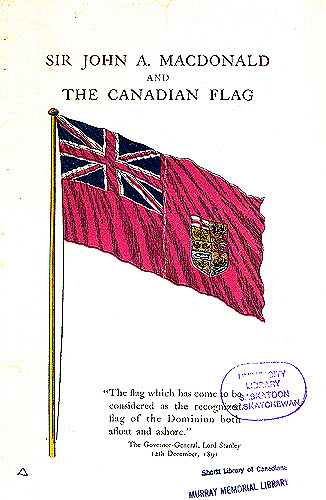 |
In 1912, John S. Ewart and Sir Joseph Pope (Under Secretary of State for External Affairs) argued in print over the appropriate flag for Canada. Ewart, noting "the steady, secular advance toward Canadian independence," argued for formal adoption of the Red Ensign; "Canada is...very nearly free of its swaddling-clothes, and most naturally it has commenced to provide itself with a flag...And the flag that has been adopted is extremely appropriate to our equivocal situation, namely, the red ensign with the Union Jack in the corner - indicative of colonialism, and the Canadian coat-of-arms in the fly - indictative of individual existence." |
Mackenzie King had gone so far as to appoint a committee to look into the issue, then dismantled it before it reported. The debate continued in the House of Commons throughout the 1930s, often as a result of private members' bills.
In October 1945, by Order-in-Council, King authorized the Red Ensign to be flown "until such time as action is taken by Parliament for the formal adoption of a national flag..." One month later, the government introduced a motion appointing a committee to "consider and report" on a distinctive national flag. This time, the committee actually met - and were inundated with over 2,000 designs and 42,000 letters from the public. Months later, they presented their recommendation: that the flag of Canada should be "the Canadian Red Ensign with a maple leaf in autmn golden colours replacing the Coat of Arms."
The Ensign, containing a Union Jack in the upper staff corner, was unpopular across the country but particularly in Quebec. King refused to accept the committee's recommendation on the grounds that it had not been unanimous.
Sixteen years later, in the 1962 Speech from the Throne, John Diefenbaker's government promised "As another means of making manifest the Canadian identity, [we] will invite the provinces to a conference for consultation regarding the choices of a national flag and other national symbols."
Asked by a reporter regarding the introduction of a bill for a distinct Canadian flag, Alvin Hamilton, a minister in Diefenbaker's government, laughed and said, "Too hot."
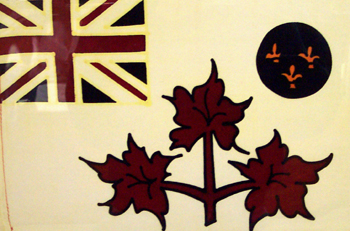 |
Silk; Ontario. Flag designed circa 1946; found in storage and sent to John Diefenbaker's office; 11 July 1964. |
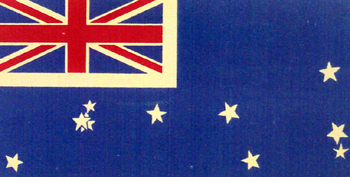 |
Flag design, 27 September 1945 One star represents the Territories and the nine remaining stars, the provinces: Newfoundland had not yet joined Confederation. "The theme of this flag is simply 'Commonwealth and Confederation.' Recently there has been much discussion concerning the adoption by Canada of a distinctive Canadian flag. It has been suggested that a distinctive flag would do much to promote Canadian unity and make people more conscious of Canada's status as an independent nation." |
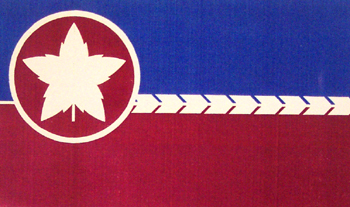 |
Anonymous flag design, ca. 1946, sent to"all members of the Senate and Members of Parliament and to all daily newspapers in Canada. The Flag's Theme: Two great races, united in nine provinces under one central government. The chevrons [arrows]...represent the first possessors of Canadian Soil, the Indians...[and are] not only emblematic of Canada's past, but also of its future [as they are] indicative of unlimited progress." |
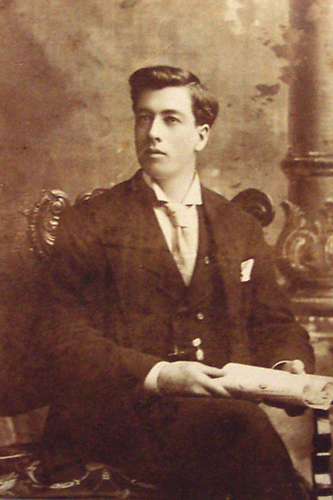 |
Cameron R. McIntosh On 25 May 1931 the debate resumed again, the result of a private members' bill introduced by C.R. McIntosh, MP for North Battleford. McIntosh argued the "flag question should be taken out of politics altogether" and asked that a special committee be appointed to consider the matter. He suggested that with "a little attention, a little courage and the utmost cooperation," the whole matter could be resolved. McIntosh envisioned three possibilities for Canada's future: absorption with the United States; the "pathway of independence;" or "autonomous community within the British Empire." A flag containing a symbol emblematic of Canada as a whole, and incorporating the Union Jack, would be "a powerful factor in developing national sentiment."The debate continued, always introduced through private members' bills, in 1933, 1935 and 1938 - without success. (Saskatchewan Archives Board photograph) |
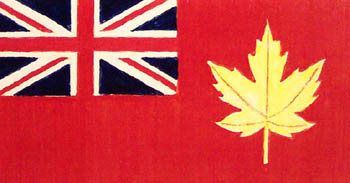 |
Original: watercolour and crayon; Nova Scotia, 26 May 1964 In 1946...when a new flag was called...The design, the Red Ensign with a gold maple leaf in place of the coat of arms was chosen. This was designed by my brother...This design was chosen from over 2,500 designs. |

